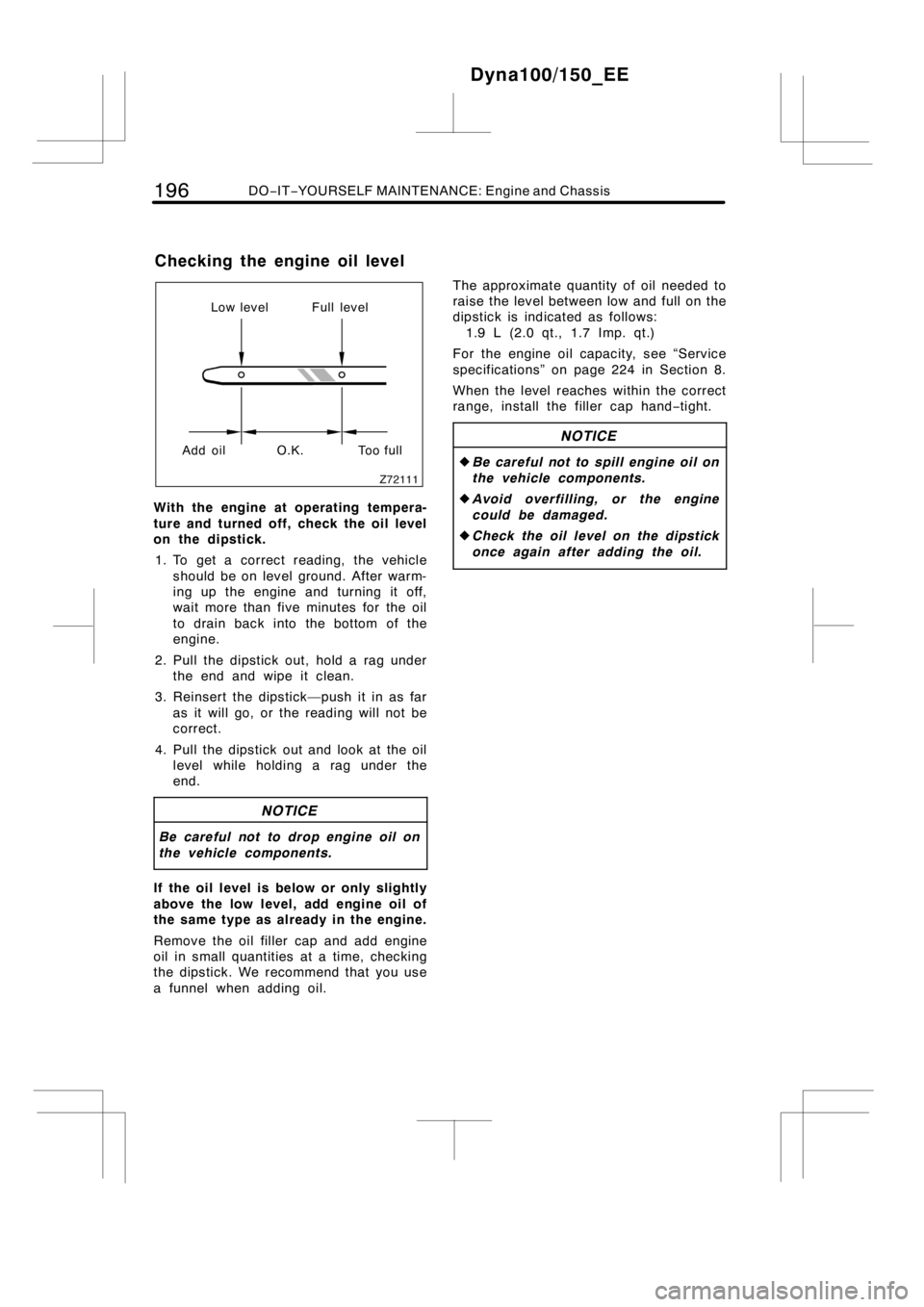engine TOYOTA DYNA 100/150 2012 (in English) Manual Online
[x] Cancel search | Manufacturer: TOYOTA, Model Year: 2012, Model line: DYNA 100/150, Model: TOYOTA DYNA 100/150 2012Pages: 240, PDF Size: 15.05 MB
Page 191 of 240

MAINTENANCE REQUIREMENTS185
Note, however, that some maintenance
tasks require special tools and skills.
These are best performed by qualified
technicians. Even if you’re an experienced
do−it−yourself mechanic, we recommend
that repairs and maintenance be con-
ducted by an authorized Toyota dealer or
repairer, or another duly qualified and
equipped professional. Any authorized
Toyota dealer or repairer will keep a
record of maintenance, which could be
useful should you ever require Warranty
Service. Should you choose to select a
qualified and equipped professional other
than an authorized Toyota repairer to
service or maintain your vehicle, we
recommend that you request that a record
of maintenance be kept.
The service interval for scheduled main-
tenance is determined by the odometer
reading or time interval, whichever
comes first, shown in the schedule.
Rubber hoses (for cooling and heater
system, brake system and fuel system)
should be inspected by a qualified tech-
nician in accordance with the Toyota
maintenance schedule.
They are particularly important mainte-
nance items. Have any deteriorated or
damaged hoses replaced immediately.
Note that rubber hoses will deteriorate
with age, resulting in swelling, chafing or
cracks.Be on the alert for changes in perfor-
mance, sounds, and visual tip−offs that
indicate service is needed. Some impor-
tant clues are as follows:
DEngine missing, stumbling, or pinging
DAppreciable loss of power
DStrange engine noises
DA leak under the vehicle (However, wa-
ter dripping from the air conditioning
after use is normal.)
DChange in exhaust sound (This may
indicate a dangerous carbon monoxide
leak. Drive with the windows open and
have the exhaustsystem checked im-
mediately.)
DFlat−looking tire; excessive tire squeal
when cornering; uneven tire wear
DVehicle pulls to one side when driving
straight on a level road
DStrange noises related to suspension
movement
DLoss of brake effectiveness; spongy
feeling brake or clutch pedal; pedal al-
most touches floor; vehicle pulls to one
side when braking
DEngine coolant temperature continually
higher than normal
If you notice any of these clues, take your
vehicle to any authorized Toyota dealer or
repairer, or another duly qualified and
equipped professional, as soon as pos-
sible. It probably needs adjustment or re-
pair.
CAUTION
Do not continue driving with the ve-
hicle unchecked. It could result in se-
rious vehicle damage and possibly se-
rious injury.
Dyna100/150_EE
Does your vehicle need
repairing?
Page 193 of 240

DO−IT−YOURSELF MAINTENANCE: Introduction187
Section 7−1
DO−IT−YOURSELF MAINTENANCE
Introduction
DEngine compartment overview 188......................
DBattery locations 190..................................
DFuse locations 190.....................................
DDo−it−yourself service precautions 193..................
Dyna100/150_EE
Page 194 of 240

188DO−IT−YOURSELF MAINTENANCE: Introduction
Front of vehicle
1. Engine coolant reservoir
2. Engine oil filler cap
3. Engine oil level dipstick
4. Radiator5. Intercooler
6. Electric cooling fan
7. Condenser
Dyna100/150_EE
Engine compartment overview
"Left−hand drive vehicles
Page 195 of 240

DO−IT−YOURSELF MAINTENANCE: Introduction189
Front of vehicle
1. Engine coolant reservoir
2. Engine oil filler cap
3. Engine oil level dipstick
4. Radiator5. Intercooler
6. Electric cooling fan
7. Condenser
Dyna100/150_EE
"Right−hand drive vehicles
Page 199 of 240

DO−IT−YOURSELF MAINTENANCE: Introduction193
If you perform maintenance by yourself,
be sure to follow the correct procedure
given in this Section.
You should be aware that improper or in-
complete servicing may result in operating
problems.
This Section gives instructions only for
those items that are relatively easy for an
owner to perform. As explained in Section
6, there are still a number of items that
must be done by a qualified technician
with special tools.
Utmost care should be taken when work-
ing on your vehicle to prevent accidental
injury. Here are a few precautions that
you should be especially careful to ob-
serve:
CAUTION
DWhen the engine is running, keep
hands, clothing, and tools away
from the moving fan and engine
drive belts. (Removing rings,
watches, and ties is advisable.)
DRight after driving, the engine
compartment—the engine, radiator,
exhaust manifold and power steer-
ing fluid reservoir, etc.—will be hot.
So be careful not to touch them.
Oil and fluids may also be hot.
DIf the engine is hot, do not remove
the radiator cap or loosen the drain
plugs to prevent burning yourself.
DDo not leave anything that may
burn easily, such as paper or rags,
in the engine compartment.
DDo not smoke, cause sparks or al-
low open flames around fuel or the
battery. Their fumes are flammable.
DBe extremely cautious when work-
ing on the battery. It contains poi-
sonous and corrosive sulfuric acid.
DDo not get under your vehicle with
just the body jack supporting it. Al-
ways use automotive jack stands or
other solid supports.
DBe sure that the engine switch is
off if you work near the electric
cooling fans. With the engine
switch on, the electric cooling fans
will automatically start to run if the
engine coolant temperature is high
and/or the air conditioning is on.
DUse eye protection whenever you
work on or under your vehicle
where you may be exposed to flying
or falling material, fluid spray, etc.
DUsed engine oil contains potentially
harmful contaminants which may
cause skin disorders such as in-
flammation or skin cancer, so care
should be taken to avoid prolonged
and repeated contact with it. To re-
move used engine oil from your
skin, wash thoroughly with soap
and water.
DDo not leave used oil within the
reach of children.
DDispose of used oil and filter only
in a safe and acceptable manner.
Do not dispose of used oil and fil-
ter in household trash, in sewers or
onto the ground. Call your dealer or
a service station for information
concerning recycling or disposal.
DTake care when filling the brake and
clutch fluid reservoirs because
brake fluid can harm your hands or
eyes. If fluid gets on your hands or
in your eyes, flush the affected area
with clean water immediately. If you
still feel uncomfortable with your
hands or eyes, go to the doctor.
Dyna100/150_EE
Do−it−yourself service
precautions
Page 200 of 240

194DO−IT−YOURSELF MAINTENANCE: Introduction
NOTICE
zRemember that battery cables carry
high currents. Be careful of acci-
dentally causing a short circuit.
zAdd only “Toyota Super Long Life
Coolant” or similar high quality eth-
ylene glycol based non−silicate,
non−amine, non−nitrite, and non−bo-
rate coolant with long−life hybrid
organic acid technology to fill the
radiator. “Toyota Super Long Life
Coolant” is a mixture of 50% cool-
ant and 50% deionized water.
zIf you spill some of the coolant, be
sure to wash it off with water to
prevent it from damaging the parts
or paint.
zDo not overfill power steering fluid,
or the power steering could be
damaged.
zIf you spill brake fluid, be sure to
wash it off with water to prevent it
from damaging the parts or paint.
zDo not drive with the air cleaner
filter removed, or excessive engine
wear could result.
zBe careful not to scratch the glass
surface with the wiper frame.
zWhen closing the engine access
hole cover or lowering the cab,
check to see that you have not for-
gotten any tools, rags, etc.
Dyna100/150_EE
Page 201 of 240

DO−IT−YOURSELF MAINTENANCE: Engine and Chassis195
Section 7−2
DO−IT−YOURSELF MAINTENANCE
Engine and Chassis
DChecking the engine oil level 196........................
DChecking the engine coolant level 198...................
DChecking the radiator, condenser and intercooler 200.....
DDraining fuel filter water 200............................
DChecking tire inflation pressure 201.....................
DChecking and replacing tires 202........................
DRotating tires 203......................................
DInstalling snow tires and chains 204.....................
DReplacing wheels 205..................................
Dyna100/150_EE
Page 202 of 240

196DO−IT−YOURSELF MAINTENANCE: Engine and Chassis
Low level Full level
Add oil O.K. Too full
With the engine at operating tempera-
ture and turned off, check the oil level
on the dipstick.
1. To get a correct reading, the vehicle
should be on level ground. After warm-
ing up the engine and turning it off,
wait more than five minutes for the oil
to drain back into the bottom of the
engine.
2. Pull the dipstick out, hold a rag under
the end and wipe it clean.
3. Reinsert the dipstick—push it in as far
as it will go, or the reading will not be
correct.
4. Pull the dipstick out and look at the oil
level while holding a rag under the
end.
NOTICE
Be careful not to drop engine oil on
the vehicle components.
If the oil level is below or only slightly
above the low level, add engine oil of
the same type as already in the engine.
Remove the oil filler capand add engine
oil in small quantities at a time, checking
the dipstick. We recommend that you use
a funnel when adding oil.The approximate quantity of oil needed to
raise the level between low and full on the
dipstick is indicated as follows:
1.9L(2.0qt.,1.7Imp.qt.)
For the engine oil capacity, see “Service
specifications” on page 224 in Section 8.
When the level reaches within the correct
range, install the filler cap hand−tight.
NOTICE
zBe careful not to spill engine oil on
the vehicle components.
zAvoid overfilling, or the engine
could be damaged.
zCheck the oil level on the dipstick
once again after adding the oil.
Dyna100/150_EE
Checking the engine oil level
Page 203 of 240

DO−IT−YOURSELF MAINTENANCE: Engine and Chassis197
ENGINE OIL SELECTION
“Toyota Genuine Motor Oil” is used in
your Toyota vehicle. Toyota recommends
the use of approved “Toyota Genuine
Motor Oil”. Another motor oil of matching
quality can also be used.
Oil grade:
ACEA C2
NOTICE
Using engine oil other than ACEA C2
may damage the catalytic converter.
Recommended viscosity (SAE):
Temperature range anticipated before
next oil change
Preferred
SAE 0W−30 is filled into your Toyota
vehicle at manufacturing, and the best
choice for good fuel economy and good
starting in cold weather.Oil viscosity (0W−30 is explained here as
an example):
The0Win0W−30 indicates the character-
istic of the oil which allows cold startabil-
ity. Oils with a lower value before the W
allow for easier starting of the engine in
cold weather.
The30in0W−30 indicates the viscosity
characteristic of the oil when the oil is at
high temperature. An oil with a higher vis-
cosity (one with a higher value) may be
better suited if the vehicle is operated at
high speeds, or under extreme load condi-
tions.
Dyna100/150_EE
Page 204 of 240

198DO−IT−YOURSELF MAINTENANCE: Engine and Chassis
To ensure excellent lubrication perfor-
mance for your engine, Toyota recom-
mends the use of “Toyota Genuine Motor
Oil”, which has been specifically tested
and approved for all Toyota engines.
Please contact any authorized Toyota
dealer or repairer for further details about
“Toyota Genuine Motor Oil”. Other motor
oils of matching quality also be used.Look at the see−through coolant reser-
voir when the engine is cold. The cool-
ant level is satisfactory if it is between
the “FULL” and “LOW” lines on the
reservoir. If the level is low, add the
coolant. (For the coolant type, see
“Coolant type selection” described be-
low.)
The coolant level in the reservoir will vary
with engine temperature. However, if the
level is on or below the “LOW” line, add
coolant. Bring the level up to the “FULL”
line.
If the coolant level drops within a short
time after replenishing, there may be a
leak in the system. Visually check the
radiator, hoses, radiator cap and drain
cock and water pump.
If you can find no leak, have any autho-
rized Toyota dealer or repairer, or another
duly qualified and equipped professional,
test the cap pressure and check for leaks
in the cooling system.
CAUTION
To prevent burning yourself, do not
remove the radiator cap when the en-
gine is hot.
Dyna100/150_EE
Checking the engine coolant
level